|
Definición de la
Real
Academia de Ciencias Exactas, Físicas y Naturales, Glosario de
Geología:
Metamorfismo. (metamorphism)
Geol. Conjunto de cambios texturales y mineralógicos que experimenta
una roca sometida a condiciones de presión y temperatura diferentes a las de
su formación (excluyendo los procesos diagenéticos de rocas
sedimentarias ya que están muy relacionados con el ambiente de depósito
sedimentario y son propios de la formación de rocas sedimentarias y
no de su transformación).
En los temas de teoría se aborda el metamorfismo, las
características de las rocas metamórficas y los procesos
metamórficos, del metamorfismo de los grandes grupos composicionales
de rocas comunes, y una síntesis sobre la evolución de las rocas y
cinturones metamórficos en el contexto de la Tectónica de Placas.
Se enfatiza la existencia de los TRES factores más
importantes que controlan las asociaciones de fases minerales en
rocas metamórficas:
Para cualquier estudioso del metamorfismo es claro que P y T
controlan las asociaciones minerales presentes en una roca dada a
través de reacciones metamórficas uni-, di-, tri-,.. variantes
(>
Regla de las fases: nº de componentes del sistema + 2 = nº de fases
+ grado de libertad; el "2" alude al número de variables intensivas
independientes, P y T, y el "nº componentes" alude al número de
variables composicionales independientes).
También es claro que para una P y una T dadas, los grandes grupos
composicionales de rocas deben tener asociaciones distintas (¿o
acaso esperaría uno encontrar la misma asociación de fases minerales
en un mármol y en una cuarcita?). Este efecto es por tanto el debido
a la composición química del protolito, considerando grandes
diferencias composicionales.
Pero lo que a veces cuesta entender algo más es que ese mismo efecto
composicional también funciona cuando las diferencias de composición
del protolito son pequeñas. Por ejemplo, dos metapelitas
metamorfizadas a la misma P y T tendrán asociaciones de fases
distintas si su composición es distinta. Incluso si su composición
es similar, aunque en este caso las diferencias serán sutiles
(quizás, solo se note en la presencia o ausencia de un mineral).
Si la composición química de las dos muestras de metapelitas
metamorfizadas a la misma P y T es muy similar, entonces sus
asociaciones minerales podrán ser las mismas, pero el efecto de la
composición de la roca debe denotarse en algo. Ese algo es, por un
lado, la abundancia de las fases (tendrán los mismos minerales, pero
no estarán en la misma proporción) y por otro en la composición de
las fases (tendrán los mismos minerales, pero no tendrán
exactamente la misma
composición química).
Todo esto es lo que se intenta sistematizar en el presente curso. El
efecto de P, T y la composición de la roca en las asociaciones
minerales que componen las rocas metamórficas.
Una vez entendido esto, podrá abordarse el significado geodinámico
de las rocas metamórficas, evaluando el significado de las
condiciones P-T de pico sufridas, la evolución P-T, y su relación
con el tiempo y la deformación.

Metamorfismo y rocas metamórficas











Variables del Metamorfismo



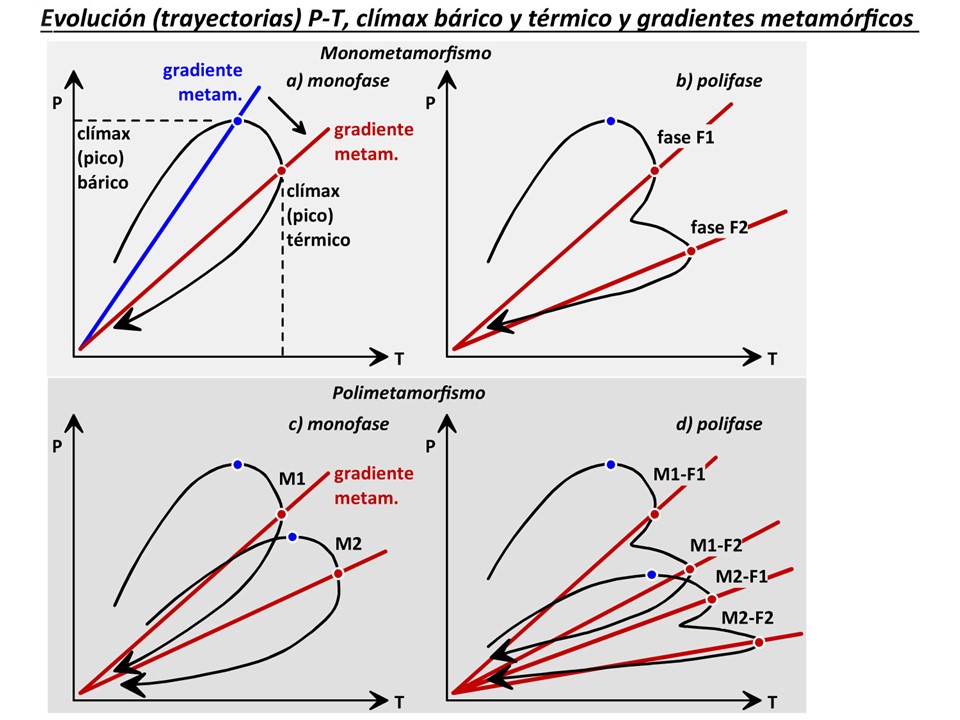







Efectos de
la composición (Facies metamórficas)




Series de
facies


Grado



Ambientes
geodinámicos




Un ejemplo de cinturón metamórfico pareado: El prisma
acrecionario Paleo-Mesozoico de Chile
Información está extraída de:
T. Hyppolito, C. Juliani, A. García-Casco, V. Meira, A. Bustamante, C. Hall. (2015) LP/HT metamorphism as a temporal marker of change of deformation style within the Late Palaeozoic accretionary wedge of central Chile. Journal of Metamorphic Geology 33, 1003–1024, DOI: 10.1111/jmg.12166.
ABSTRACT. A Late Palaeozoic accretionary prism, formed at the southwestern margin of Gondwana from Early Carboniferous to Late Triassic, comprises the Coastal Accretionary Complex of central Chile (34–41°S). This fossil accretionary system is made up of two parallel contemporaneous metamorphic belts: a high‐pressure/low temperature belt (HP/LT – Western Series) and a low pressure/high temperature belt (LP/HT – Eastern Series). However, the timing of deformation events associated with the growth of the accretionary prism (successive frontal accretion and basal underplating) and the development of the LP/HT metamorphism in the shallower levels of the wedge are not continuously observed along this paired metamorphic belt, suggesting the former existence of local perturbations in the subduction regime. In the Pichilemu region, a well‐preserved segment of the paired metamorphic belt allows a first order correlation between the metamorphic and deformational evolution of the deep accreted slices of oceanic crust (blueschists and HP greenschists from the Western Series) and deformation at the shallower levels of the wedge (the Eastern Series). LP/HT mineral assemblages grew in response to arc‐related granitic intrusions, and porphyroblasts constitute time markers recording the evolution of deformation within shallow wedge material. Integrated P–T–t–d analysis reveals that the LP/HT belt is formed between the stages of frontal accretion (D1) and basal underplating of basic rocks (D2) forming blueschists at c. 300 Ma. A timeline evolution relating the formation of blueschists and the formation and deformation of LP/HT mineral assemblages at shallower levels, combined with published geochronological/thermobarometric/geochemistry data suggests a cause–effect relation between the basal accretion of basic rocks and the deformation of the shallower LP/HT belt. The S2 foliation that formed during basal accretion initiated near the base of the accretionary wedge at ~30 km depth at c. 308 Ma. Later, the S2 foliation developed at c. 300 Ma and ~15 km depth shortly after the emplacement of the granitoids and formation of the (LP/HT) peak metamorphic mineral assemblages. This shallow deformation may reflect a perturbation in the long‐term subduction dynamics (e.g. entrance of a seamount), which would in turn have contributed to the coeval exhumation of the nearby blueschists at c. 300 Ma. Finally, 40Ar–39Ar cooling ages reveal that foliated LP/HT rocks were already at ~350 °C at c. 292 Ma, indicating a rapid cooling for this metamorphic system.
Hyppolito, T., García-Casco, A., Juliani, C., Meira, V.T., Hall, C.
(2014). Late Paleozoic onset of subduction and exhumation at the western margin of Gondwana (Chilenia Terrane): Counterclockwise P-T paths and timing of metamorphism of deep-seated garnet-mica schist and amphibolite of Punta Sirena, Coastal Accretionary Complex, central Chile (34° S). Lithos 206–207, 409–434, DOI: 10.1016/j.lithos.2014.07.023.
ABSTRACT: In this study, the Paleozoic albite–epidote–amphibolite occurring as meter-sized intercalations within garnet–mica schist at Punta Sirena beach (Pichilemu region, central Chile) is characterized for the first time. These rocks constitute an unusual exposure of subduction-related rocks within the Paleozoic Coastal Accretionary Complex of central Chile. Whereas high pressure (HP) greenschist and cofacial metasediments are the predominant rocks forming the regional metamorphic basement, the garnet–mica schist and amphibolite yield higher P–T conditions (albite–epidote amphibolite facies) and an older metamorphic age. Combining detailed mineral chemistry and textural information, P–T calculations and Ar–Ar ages, including previously published material from the Paleozoic Accretionary Complex of central Chile, we show that the garnet–mica schist and associated amphibolite (locally retrograded to greenschist) are vestiges of the earliest subducted material now forming exotic bodies within the younger HP units of the paleo-accretionary wedge. These rocks are interpreted as having been formed during the onset of subduction at the southwestern margin of Gondwana. However, we show that the garnet–mica schist formed at a slightly greater depth (ca. 40 km) than the amphibolite (ca. 30 km) along the same hot-subduction gradient developed during the onset of subduction. Both lithotypes reached their peak-P conditions at ca. 335–330 Ma and underwent near-isobaric cooling followed by cooling and decompression (i.e., counterclockwise P–T paths). The forced return flow of the garnet–mica schist from the subduction channel started at ca. 320 Ma and triggered the exhumation of fragments of shallower accreted oceanic crust (amphibolite). Cores of phengite (garnet–mica schist) and amphibole (amphibolite) grains have similar chemical compositions in both the S1 and S2 domains, indicating rotation of these grains during the transposition of the burial-related (prograde peak-T) foliation S1 by the non-coaxial exhumation-related foliation S2. During exhumation and retrograde D2 deformation, the garnet–mica schist and amphibolite were tectonically mingled at a depth of ca. 30 km at ca. 315 Ma. We propose that the Punta Sirena unit comprises a “pseudo”-coherent sequence formed by heterogeneous lithologies that followed non-chaotic exhumation mingling, now representing the remnants of the fossil subduction channel developed at the onset of the Late Paleozoic subduction at central Chile.
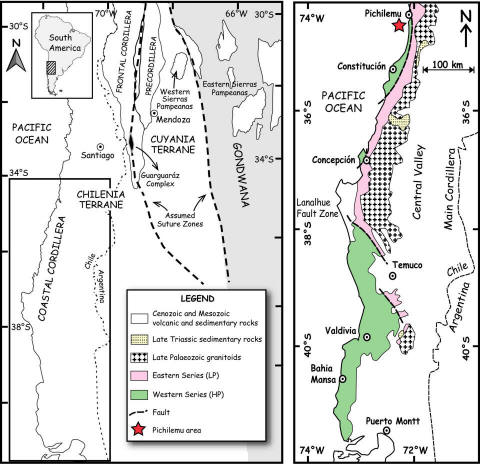 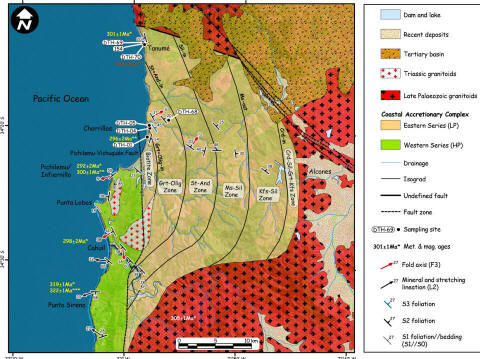
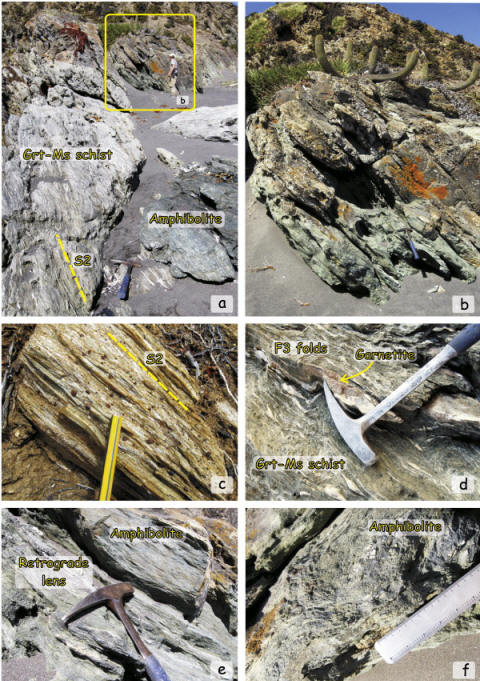 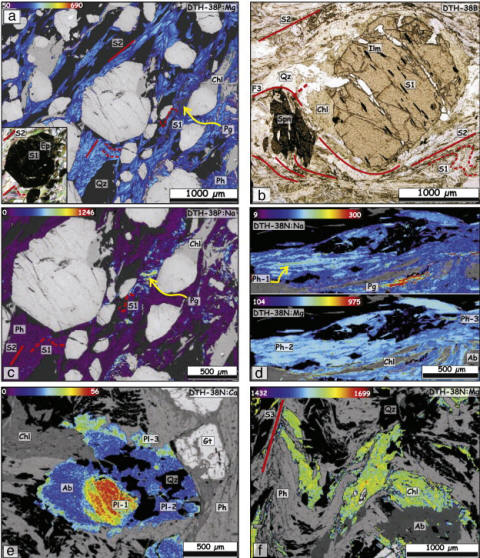
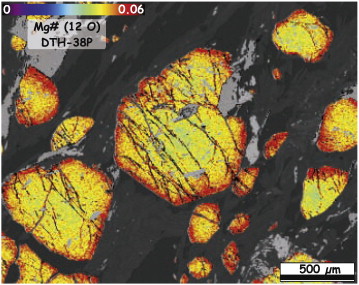 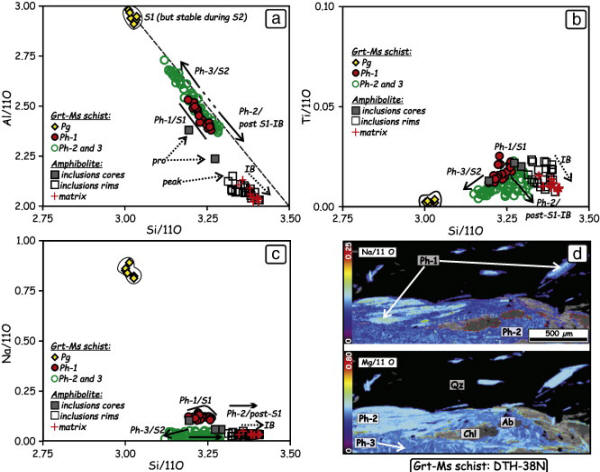
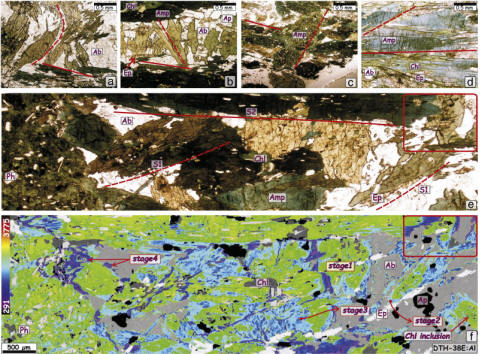 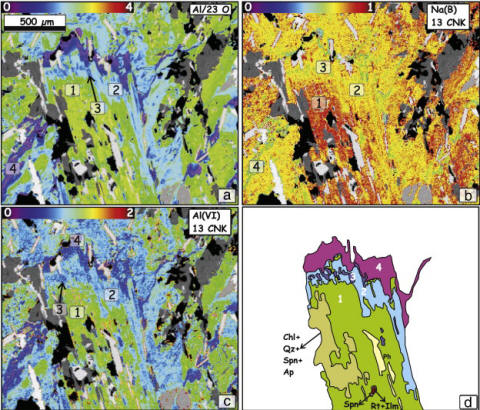
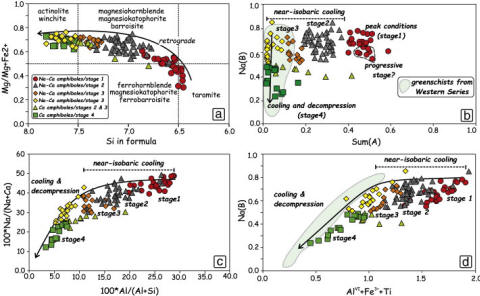 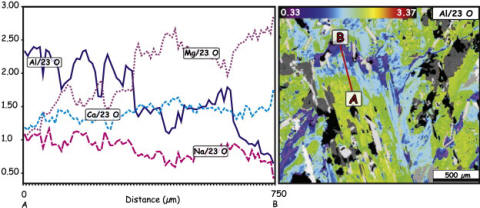
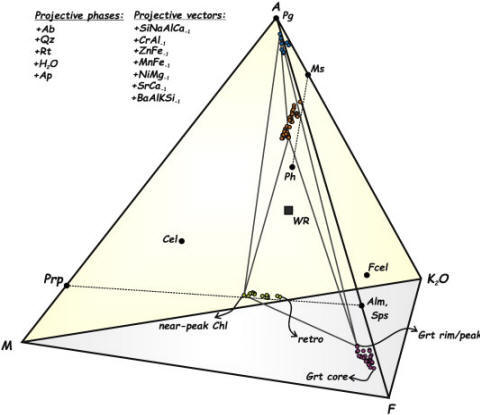 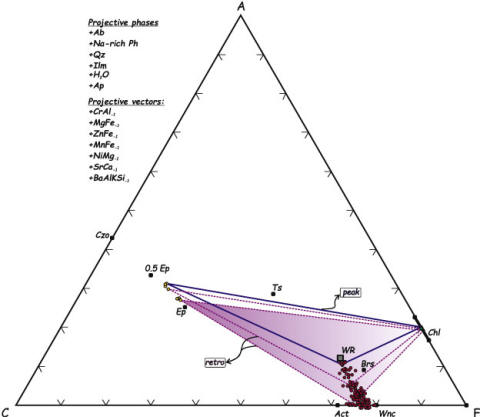
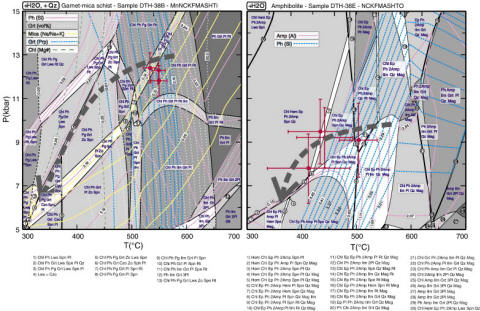 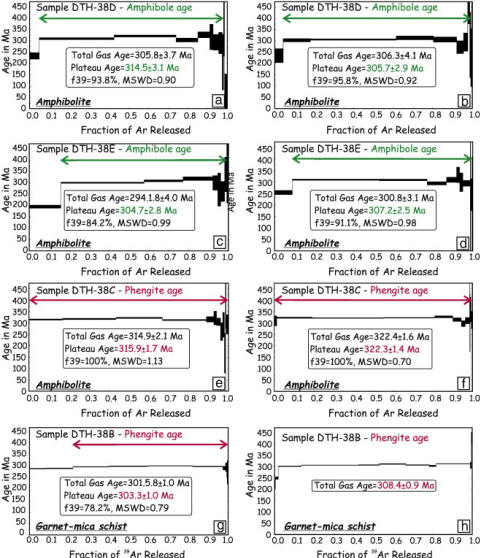
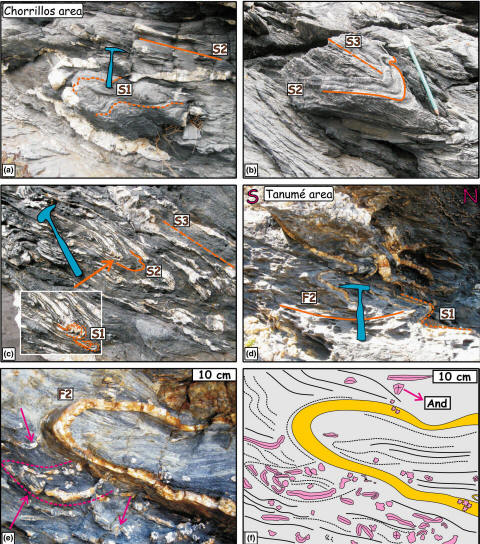 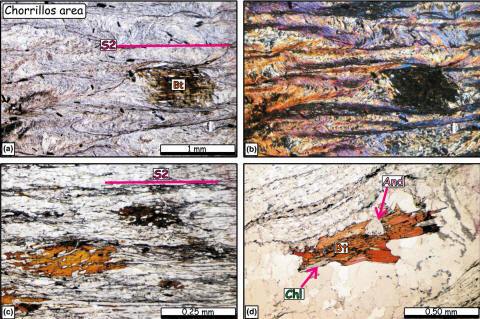
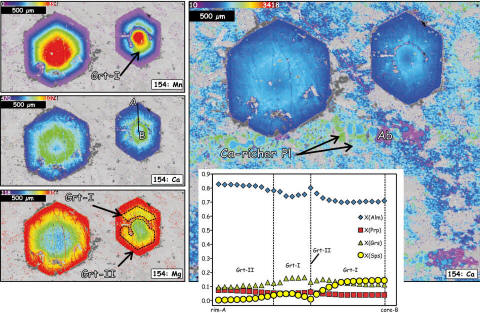 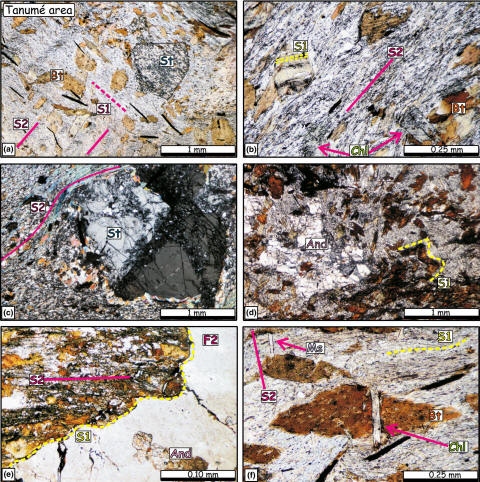
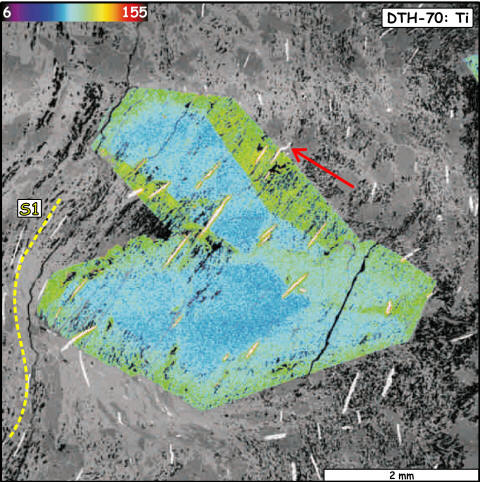 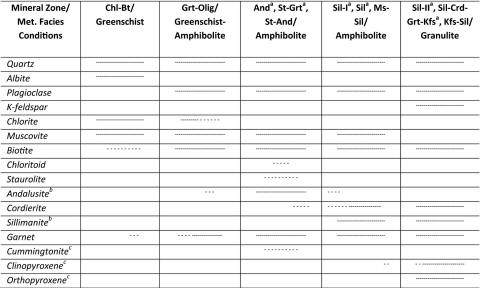
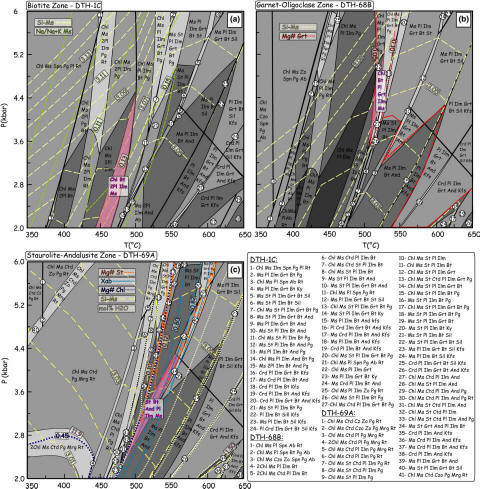 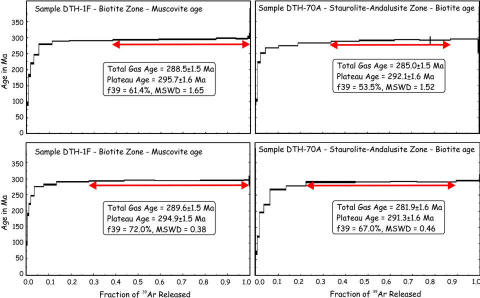
CINTURÓN METAMÓRFICO PAREADO
PALEO-MESOZOICO DEL PRISMA ACCRECIONARIO CHILENO
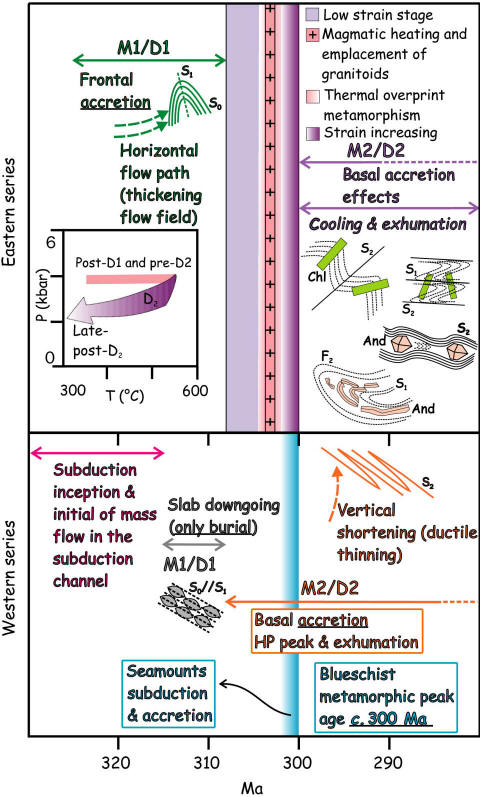
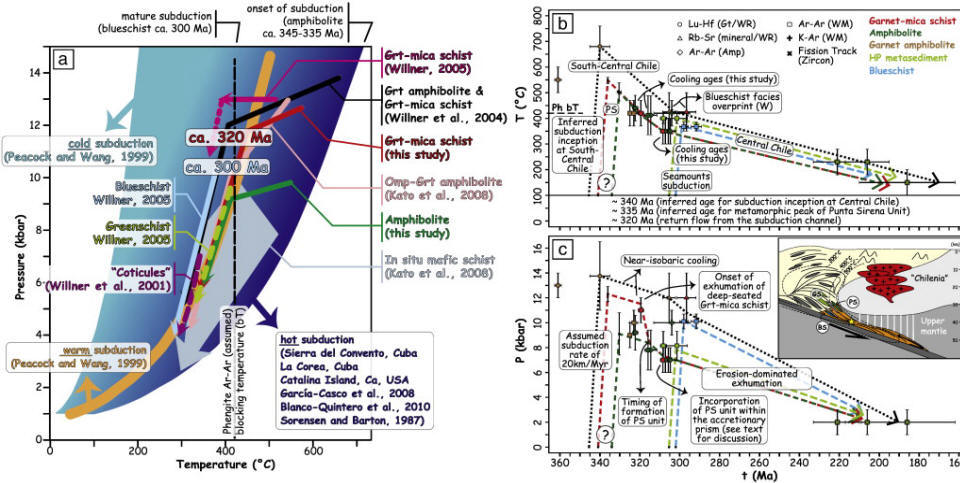
|